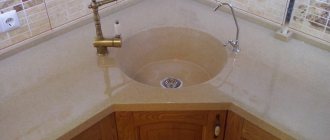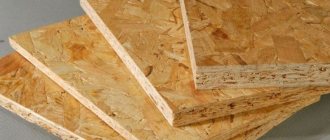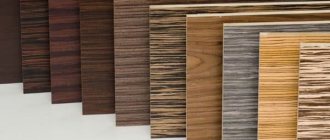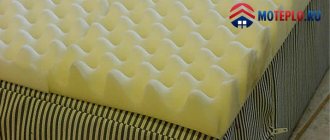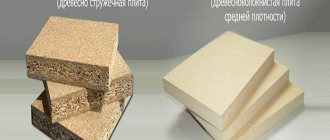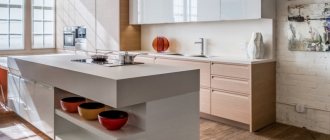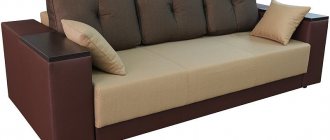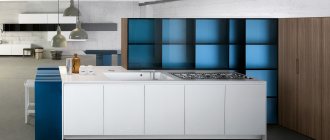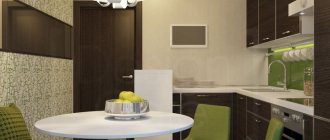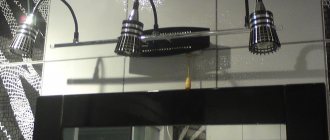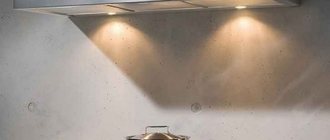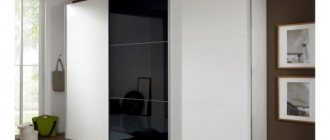Many customers of cabinet furniture initially do not understand what material it should be made of and what they should pay special attention to. Some questions can drive you into a blind corner - for example, what is better for the kitchen, MDF or chipboard, what should the set be made from so that it lasts for several years and does not lose its former attractiveness?
Experienced furniture makers will always tell you that this kind of furniture in the kitchen is used in conditions of high humidity, large temperature changes, and regular mechanical and chemical influences. All these factors must be taken into account when designing a headset.
What is chipboard and MDF board?
The production of MDF and chipboard occurs using similar technologies and at first glance, it is quite difficult to find external differences between them. But if we take a closer look at their production in general and the raw materials used for it in particular, the differences that affect the scope of application of the materials will be quite significant.
Chipboard - production and use
The raw material for producing chipboard sheets (particle board) is sawdust. The production process consists of mixing raw materials with a binder, which uses various formaldehyde resins, and pressing the resulting mass.
Chipboards.
When the base is ready, an outer decorative layer can be glued onto it, resulting in such subtypes of material as laminated chipboard (laminated chipboard) and KDSP (laminated chipboard). In the second case, paper “set” on glue is used as a covering, which in many respects is inferior to laminate, but is more attractive in price.
Chipboard boards.
The areas of application of chipboard are the production of cabinet furniture, cargo packaging and various construction works.
MDF - production and use
Technologically, the production of MDF boards (fibreboard) is similar to the production of paper - at least the preparation of raw materials is done in the same way up to a certain point.
To create MDF, not whole shavings and sawdust are used, but crushed to the state of individual wood fibers. This means that any waste from the wood processing industry can be used as a raw material.
At the first stage of preparing the raw material, it is ground to the size of crumbs, after which it is cleaned with hot steam, which is supplied under pressure. After this, the cleaned and moistened mass is fed to a defibrator, which finally grinds its particles to a minimum size.
The last stages of production are drying the raw materials, mixing the entire mass with special resins and hot pressing into finished slabs. The result is a material that in many respects is not inferior to natural solid wood. It found its main application in the furniture industry, since in other industries it is more profitable to use cheaper analogues.
MDF boards of various thicknesses.
You can learn more about all the characteristics of materials only by comparing them with each other. This will clearly show how chipboard differs from MDF and which is better to choose for certain tasks.
Comparison of characteristics
To choose the most suitable option for rough or fine finishing of a floor structure, it is necessary to take into account the main parameters of the product.
Environmental friendliness
Health safety is one of the main factors. The indicators of wood-based panel materials comply with the standards reflected in standardization documents.
- Plywood. Eco-friendly option. The most harmless products are those that are glued using natural resins.
- OSB. It does not pose a threat, but only if the production technology is followed. It is better to choose trusted manufacturers.
- Chipboard. This variety causes the most controversy regarding health hazards, since formaldehyde resins are used for gluing. Products must comply with standards (marking E1 or E0.5).
- Fiberboard. Does not pose a threat provided that high-quality raw materials are used.
- MDF. Eco-friendly material made using urea resins. These products must also comply with class E1 or E0.5.
Since the outside of all materials is finished, harmful fumes are minimized.
Strength
To choose the most reliable option, you need to take into account the density and structure of the product:
- OSB and plywood. Oriented strand panels can withstand heavy loads well: the layers are placed in different directions and glued together extremely firmly. But wood-laminated board may have a significant disadvantage - the possibility of deformation due to non-compliance with the technology.
- Chipboard and fibreboard. They have sufficient hardness. Their areas of use are somewhat different. Wood-shaving parts are thick, and wood-fiber parts are very unstable in bending, so they cannot be used for leveling voids.
- MDF. A relatively soft material that is not used in places with high loads.
It is difficult to compare all products on this parameter, since they have different sizes.
Dimensions
The length and width of all varieties are approximately the same, so it is necessary to compare the thickness:
- Hardboard. The thinnest material. Its thickness can reach up to 7 mm, but the most common is 3.2 mm.
- Plywood. For the floor, products with a thickness of 12–15 mm are selected.
- OSB. Can be of different sizes, but for flooring options from 10 to 22 mm are used. If you need to level the existing base, then a thickness of 1 cm is suitable, but in order to lay the material on wooden logs, the parts must be more durable.
- MDF. Due to their softness, the recommended thickness of the slabs varies from 18 to 25 mm.
- Chipboard. For horizontal structures with increased load, a tongue-and-groove version with a thickness of 16–22 mm is used.
The thickness and structure of the parts also affects protection from sound penetration and heat retention. If the noise pollution is very strong, then it is recommended to give preference to medium-density fiberboards of maximum thickness. They also serve as additional thermal insulation, which is similar to OSB.
Price
The difference in the price of materials depends on many factors: production method, raw materials used, additional processing, size and even place of sale.
- The most expensive is high-grade plywood.
- The cost of MDF is calculated per square meter and depends on the manufacturing method.
- The price of OSB-3 and 2 corresponds to wood-laminated boards of grade 3 or 2 of a smaller size.
- The lightest and cheapest option is fiberboard.
To ensure that the total work budget does not amount to too significant an amount, it is necessary to immediately determine the scope of application of each type of product.
Easy to install
Laying wood boards is not difficult; it does not require professional skills or complex tools. The order of work depends on the specific situation:
- If a frame structure is being erected, then OSB would be the best option.
- The light weight and thickness of hardboard make processing the fastest, but it is not suitable for serious leveling.
- Chipboard and OSB panels are cut and fixed almost identically. They are much easier to trim than MDF, which due to its dense structure offers more resistance.
- The most labor-intensive material to process is plywood. It will take much longer to place the product. It is more difficult to drill or adjust to size due to the presence of layers of natural wood in the structure.
All floor slabs are mounted on glue or joists, the only exception is the fiberboard covering: these sheets are not intended for laying on joists, they need a flat and durable base
Strength and Density
This parameter is directly affected by the raw materials used in production. Since chipboard is made from solid chips, which can be arranged in any order, its average density will be different, and in a fairly large range - from 350 to 650 kg/m³. At the same time, there are several varieties of chipboards, which differ from each other in compaction density and the ratio of raw materials to the amount of binders.
During the production of MDF, the raw materials are crushed to an almost homogeneous state, so there are no such large differences in density - the average is in the range of 720-870 kg/m³.
As a result, MDF is significantly stronger in strength than chipboards, and in some cases, even certain types of solid natural wood.
Which material is more environmentally friendly: chipboard or MDF?
According to this indicator, all the cones go to the share of chipboard, since formaldehyde resin is used as a binder in its production. In addition to the fact that these are simply compounds of substances harmful to human health, they also actively evaporate from the surface of the stove. The intensity of evaporation is affected by temperature.
According to the environmental safety class in Europe, chipboard sheets are made into two types - E1 and E2, but if this material is made according to domestic standards, then all its parameters are regulated by a single GOST. This does not allow for an accurate classification, the need for which is long overdue, since E2 is prohibited for use in the manufacture of children's furniture, and in some countries it is completely discontinued.
The MDF production technology involves the use of the dry pressing method, which is produced under high pressure and temperature. The binder is also used here, but it uses urea resins that are less harmful to humans. To be fair, it should be noted that they also contain formaldehyde, but a small amount, and in the manufacture of MDF, the resins are additionally modified with melanin, which significantly reduces the already small amount of evaporation.
The emission of harmful substances contained in MDF is significantly lower than in chipboard, therefore, in terms of environmental friendliness, fiberboards are superior to chipboards.
Let's compare what is more suitable for kitchen furniture
Try to compare the main advantages and disadvantages of each material - this will allow you to choose the most suitable option for yourself.
The main requirements that kitchen furniture must meet are:
- Environmental cleanliness;
- Resistant to moisture;
- Strength;
- Beautiful surface design;
- Affordable price.
Let's look at compliance with these requirements in furniture that is assembled from MDF or wood-based analogues.
If you decide to purchase chipboard furniture, you should find out what type of material it is made from. Even for the most budget option, you should not risk your health and purchase furniture assembled from environmentally hazardous E2 class chipboard.
If you are guided by considerations of complete environmental friendliness of the material, then it is better to give preference to laminated chipboard or MDF - this way you will be guaranteed against the fact that your furniture in the kitchen will become a source of toxic fumes.
MDF has the greatest moisture resistance, since moisture-resistant materials - lignin and paraffins - are used to glue wood components. Therefore, such furniture will be most resistant to moisture. In second place is laminated chipboard. The water-repellent film covering the surfaces protects the furniture from exposure to water. Chipboards are in the worst position - the “bare” board is generally not suitable for kitchen surfaces, and the laminated board is not sufficiently protected from moisture penetration due to possible peeling of the protective layer.
Furniture items are intended for long-term use, therefore the type of material from which they are made is one of the main criteria when assessing the feasibility of purchasing them. It is clear that there are many nuances that affect the service life of products - the care of the owners, operating conditions (temperature, humidity in the room) and a number of other factors. To understand which furniture will turn out better, you need to understand what laminated chipboard and MDF are and what properties they are characterized by. Then any of us will be able to make the optimal choice, depending on the circumstances.
This abbreviation stands for “laminated chipboard.” It is based on compressed sawdust and shavings, which are held together using formaldehyde resins. There are products on sale from different manufacturers, but high-quality products are always three-layer. In the center there are raw materials with larger fractions, and small ones are used for the outer layers.
Chipboard used for furniture is subject to surface finishing. It is made using film (paper + melamine resin). This coating is pressed into the base, so the samples are distinguished from ordinary particle board by their greater strength and moisture resistance.
What to consider
All chipboards are divided into classes. “E1” is characterized by a minimal formaldehyde content. Therefore, when choosing furniture for residential premises (especially for children's rooms, bedrooms), it is necessary to clarify this parameter using the accompanying documentation (certificate). Class “E2”, if purchased, is only for utility rooms, since such products are more “harmful”. “E3” samples are generally prohibited from being used inside buildings, since the proportion of harmful resins in their composition reaches 30%. Considering the structure of chipboards, it is clear that they are not distinguished by high strength, especially fracture resistance. Constant disassembly/assembly or dragging furniture from place to place leads to rapid wear of the material in the locations of the sockets for fasteners. At high temperatures (for example, in the area where the oven is located), the finish may begin to peel off and warp. It will no longer be possible to restore it to its original form.
This is worth paying attention to when making a kitchen set.
Features of MDF
This is a wood fiber board. It differs in that in its production small fractions are used, which are subjected to special processing. Such products are distinguished not only by greater density, but also by weight. Compared to laminated chipboard, there is practically no emission of harmful fumes. Essentially, it is an intermediate option between solid wood and particle board.
The first thing to consider when choosing kitchen furniture is its functionality.
But equally important is an attractive appearance. You also need to take into account the price of furniture
Many people want to get high-quality and beautiful furniture for little money. But which is better: MDF or chipboard for the kitchen?
Which board is more resistant to moisture: chipboard or MDF?
In its pure form, the chipboard slab does not tolerate moisture very well - when wet, its base actively begins to absorb water and can increase its volume by about 30%. Laminate chipboard has slightly better moisture resistance - laminate itself is not afraid of water and can resist getting wet for quite a long time, which is why it is often used to create budget-class countertops.
It has proven itself to be excellent, but if the outer coating is damaged, all the shortcomings are fully revealed - if water seeps into the slab, it will be actively absorbed.
Chipboard that has been wet.
Since MDF itself is a denser material, even without an external coating it resists getting wet well and, even if it gets into water, it can hold its shape for several hours, which is superior even to some types of natural wood.
So how to choose the material for your furniture?
Here is our memo in the form of simple theses:
- Laminated chipboard is perfect for the living room and hallway. Just make sure that the stove is of high quality. Request a certificate confirming the class of the slab.
- The combination of chipboard and MDF is suitable for children's bedrooms and bedrooms, but the rule is the same: the material must be of high quality, and the product must be well glued, including edges and joints.
- For the kitchen and bathroom, it is better to choose MDF: in these rooms it is most often exposed to changes in temperature and humidity.
What is more difficult to process: chipboard or MDF?
As in the case of density, the raw materials used in production are responsible for this parameter. Since chipboard consists of solid chips, it lends itself very poorly to fine processing - all cutting lines that are not straight can lead to chipping.
Since finely divided raw materials are used to create MDF, this is reflected in the structure of the material, which is more uniform and dense. This material easily tolerates any type of processing - sawing, figure cutting or milling.
Milled MDF.
Due to its ease of processing, MDF is widely used in the manufacture of carved facades, trims and moldings used in furniture production. According to this indicator, MDF has the upper hand.
Decorative coating: finishing layer options ↑
The agony of choice begins when you try to settle on a finishing coating option. What kind of kitchen should it be: plastic or enamel, PVC film or veneer? How to choose the type of MDF facade for the kitchen and not make a mistake? First of all, decide on the shape and appearance of the facade: this will simplify the task and narrow the range of decorative coatings under consideration.
Difficult and responsible choice: which kitchen facades are better
Lamination and lamination: budget facades ↑
Budget-friendly: laminated board set
The factory technology for applying a decorative and protective layer is lamination. Cover molded products - slabs - with film. The finished slab is cut to size, and the edges are treated with a special tape or acrylic edge edging. Feature: only smooth surfaces are laminated.
Laminated board: layers
Before applying the protective layer, the slab is polished. After preparation, a layer of film is pressed to the surface under the influence of temperature and a press. Melamine coating is used. The paper base with decor is processed in several stages. Both sides of the paper are treated with resin, which melts when the temperature rises and impregnates the paper base. The use of resins improves the characteristics of the material: the transparent layer protects the plate from soaking, abrasion and minor scratches.
Melamine film roll: production
Laminating is the gluing of paper film onto a prepared base. Fixation is carried out using adhesive and a press.
Wood decor options
Advantages:
- Low cost.
- Wide selection of shades and decor options.
Among the disadvantages are poor performance characteristics. Considering that only the top and bottom surfaces are laminated, the edges remain unprotected and require careful additional sealing. The coating is not durable. The surface easily chips from impacts, and in the place where the integrity of the film is broken, the slab begins to collapse.
PVC film for MDF: advantages of the material ↑
Most MDF kitchens are covered with film. Polyvinyl chloride, a synthetic material, is used to cover the panels. The film is not afraid of water, easily takes the desired shape when heated, has minimal elasticity, and is quite resistant to damage.
The process of applying material to MDF for the kitchen is fundamentally different from factory lamination. Finished facades are covered with film, not slabs.
Selection of PVC film
Before facing, the slabs are cut, milled, and shaped: bent, radius. Place the finished products on a flat surface. The film is glued using a vacuum machine.
Feature: both the front and side surfaces of the plate are closed at the same time. There is no need to seal the joints and cover the ends with edging material.
Pasting on a vacuum machine
There are an incredible number of design options for films for facades. Among the most popular:
- Wood-effect film for MDF. Not only the shade, but also the wood pattern is imitated. In combination with milling, the papered facade cannot be distinguished from a wooden one. In classic sets, patinated facades are used - an artificial patina composition is applied over the film, which visually “ages” the wood.
Film facade “under the tree” with patina
- Plain glossy. Film with a fashionable “plastic” finish.
Glossy and textured materials
- Matte, combined with a pattern. Used for cladding smooth facades of furniture in a modern style.
Drawing on the finishing layer
- With 3D drawings and photographs. Manufacturers offer both ready-made films with decor and individual designs with the ability to print on film.
- Imitation stone. Mostly MDF with a “stone” film is used for countertops in inexpensive kitchens.
Under the stone: material for countertops
The only drawback of film facades is fading in direct sunlight. The maximum temperature that the coating can withstand is 70°C. If overheated, the film may peel off or begin to melt.
Plastic coating: how an acrylic facade is made ↑
Kitchens made of MDF with plastic as cladding are durable. The thickness of the acrylic plates that are glued to the fiberboard is about 1 mm. The plastic is fixed using glue and a press.
Plastic on facades
What is better for the kitchen: plastic or film? It is impossible to distinguish the coating materials externally. Both plastic and film cover the slab from above and from the sides. But if the film is flexible enough to cover a panel with a complex shape, cover a façade with threads, or milled ones, then the plastic can only be glued to a smooth and even surface. The maximum is a beveled edge.
Glossy plastic on MDF board
For kitchen sets in high-tech style, modern sets with a laconic design and clear geometry, plastic is preferable. The linings do not fade over time, are more durable and resistant to chipping.
For cladding kitchen facades made of MDF, HPL plastic is used. The coating is multi-layered. Design options include gloss, wood and leather textured materials.
Painted surfaces: features of production and care ↑
Another option for finishing decor for an MDF facade is enamel. Coloring is a complex, labor-intensive and lengthy process. Painting occurs in the same way as in a car workshop. First, the surface is prepared and coated with a special primer, which ensures that the paint layer adheres to the base.
The dyeing process in a special chamber
The enamel is applied in several layers. The result - the strength of the coating and appearance - depends on their quantity. Each layer is left to dry, then treated with sandpaper. The finishing layer is varnish.
Standard painting options:
- Glossy.
Glossy painted details
- Semi-gloss.
- Matte.
Sample parts
Painting with special effects will cost more. They use the “chameleon” effect, when the color changes depending on the strength and angle of lighting. Also, airbrush masters can recreate any picture of the customer’s choice on the surface of the kitchen facade made of MDF with enamel.
Chameleon effect
When choosing which is better – plastic or enamel, pay attention to the shape of the facades. It will not be possible to cover a product with a complex shape with plastic, but you can even paint a 3D textured façade in the chosen shade.
Non-standard solution: complex shape and matte shade
Fans of extraordinary design will enjoy painted facades followed by the application of decor using the decoupage technique and artificial “aging” of the enamel.
Painted facade with decor
Veneering of slabs: expensive material with impeccable appearance ↑
Connoisseurs of natural materials who do not want to buy a set of MDF with plastic or film will be attracted by veneered furniture. A thin veneer of natural wood is glued onto a flat slab. Subsequently, the surface is treated: varnished, tinted, or waxed.
Slab veneering
Externally, a veneered facade is indistinguishable from a wooden one. The advantage is savings: furniture made from solid wood will cost much more than a set of wood-fiber board covered with veneer.
Veneer coated with enamel and varnish
Disadvantages are the relatively high price and care features. It must be remembered that two materials are combined that react differently to changes in temperature and moisture levels in the room. If MDF tolerates temperature fluctuations without deformation, the veneer may peel off, crack, or become covered with waves.
Possibilities for decorating chipboard and MDF
In the case of particle boards and fibreboards, decoration means finishing these materials with additional layers of laminate or veneer. If in the second case there are usually no problems, then when decorating with laminate or paper with chipboard there may be difficulties. They are caused by the initially rough surface of the slab - if a thin film is glued to it, then all the tubercles and veins will be visible on it. As a result, all chipboard slabs are sanded and only after that can film or paper with a pattern be applied to them.
MDF sheets are initially devoid of such disadvantages due to their density - immediately after production they are suitable for applying any decorative coating.
Fastener retention
Chipboard has long gained the reputation of a “disposable” material - furniture assembled from it is very difficult to disassemble without loss, transport to another place and reassemble. This is due to the fastenings, which, even if the screws are screwed in and out perfectly evenly during reassembly, at best will hold much weaker. The worst is also the more likely outcome - the attachment point will simply crumble and you will have to additionally treat it with glue or use screws of larger diameter.
As a result, if you have a choice, then you should take furniture made of chipboard, in which not screws are used as fasteners, but bolted connections with wide washers. If they break, then you won’t have to worry about the possibility of restoring the fasteners.
MDF, due to its density, easily tolerates repeated assembly and disassembly - in this, again, it is not very different from natural wood.
What is cheaper: chipboard or MDF?
According to this criterion, chipboard will give odds to any material. Of course, you can take into account the types and quality of the external coating and its finishing, impregnation with water and fire-resistant compounds, but in general the difference in cost between MDF and chipboard will be about 50%.
If you compare slabs coated with good plastic, enamel or natural veneer, the difference will be even greater, but here you have to choose between the desire to save here and now when purchasing or in the future - on operation.
